The Covid-19 crisis made it obvious we are at risk if we don’t manage our dependencies to our suppliers and partners along the whole supply chain. They are an essential part of our value stream/s we need to take into consideration to achieve true Business Agility. In other words we are only as agile as our partner ecosystem is.
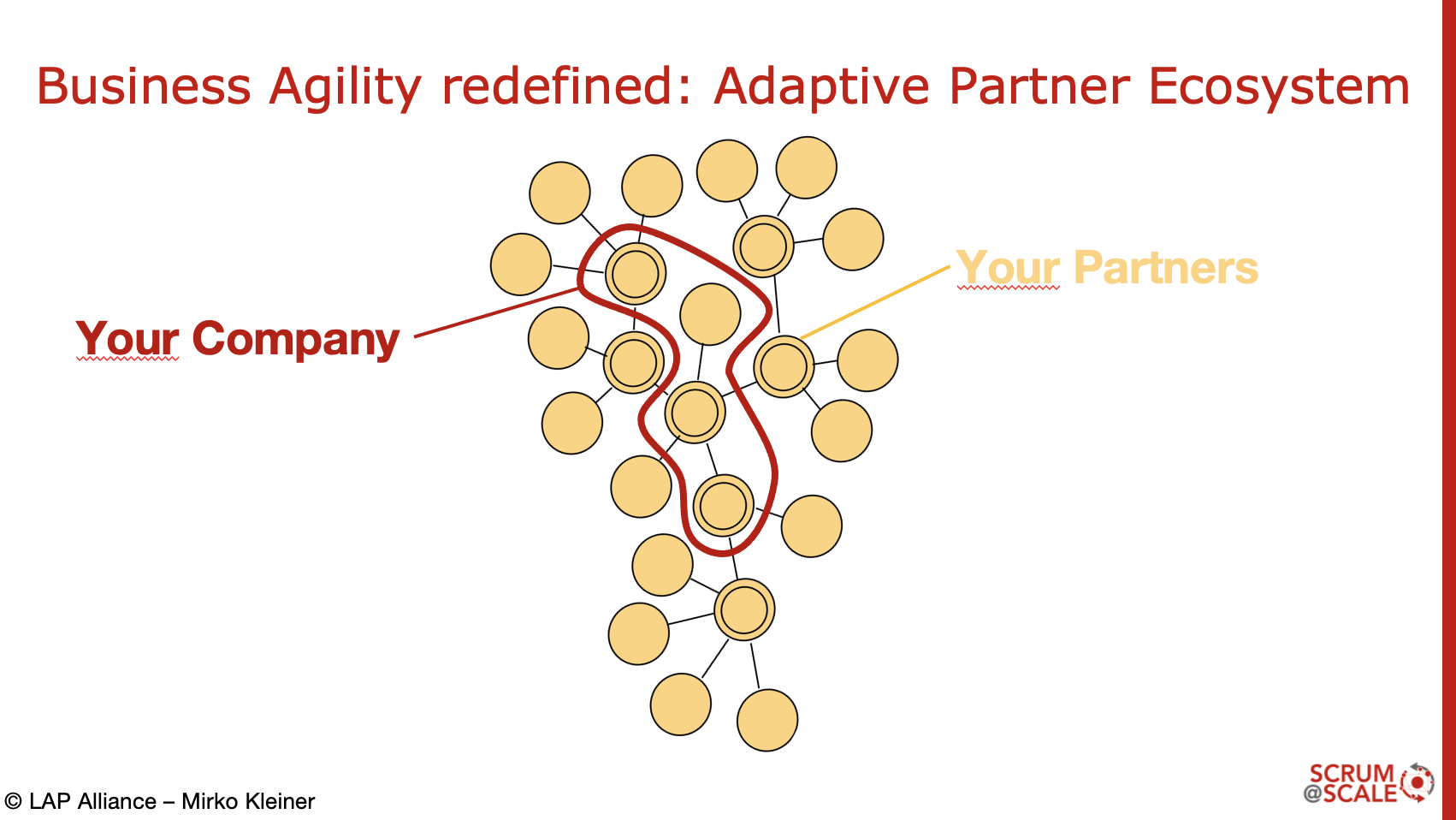
In this article you’ll learn why Tesla never had a chip shortage, how you could select new strategic partners in DAYS instead of Months and so how to start scaling agile beyond your company with your preferred Agile Framework 1 and Lean-Agile Procurement 2 (Short LAP).
A RETROSPECTIVE - SCALING CROSS-COMPANY TODAY
If you’re not an agilist you need to know that out of good practices a number of scaling frameworks have evolved in the past years. You might have heard of SAFe1.1, [email protected], the Spotify “Model”1.3, Agile@Scale DA1.4, LESS1.5 or NEXUS1.6. The purpose of all of them was to scale the benefits of aligning around value with cross-functional teams to the whole organization.
Find out more about the benefits of these scaling frameworks in the Annual State of Agile Report.
WHERE ARE THE SUPPLIERS IN THE AGILE SCALING FRAMEWORKS?
The suppliers are basically treated as team members, full cross-functional teams or even integrated services. Depending on the business suppliers might have other important roles e.g. as advisors in the portfolio, etc.
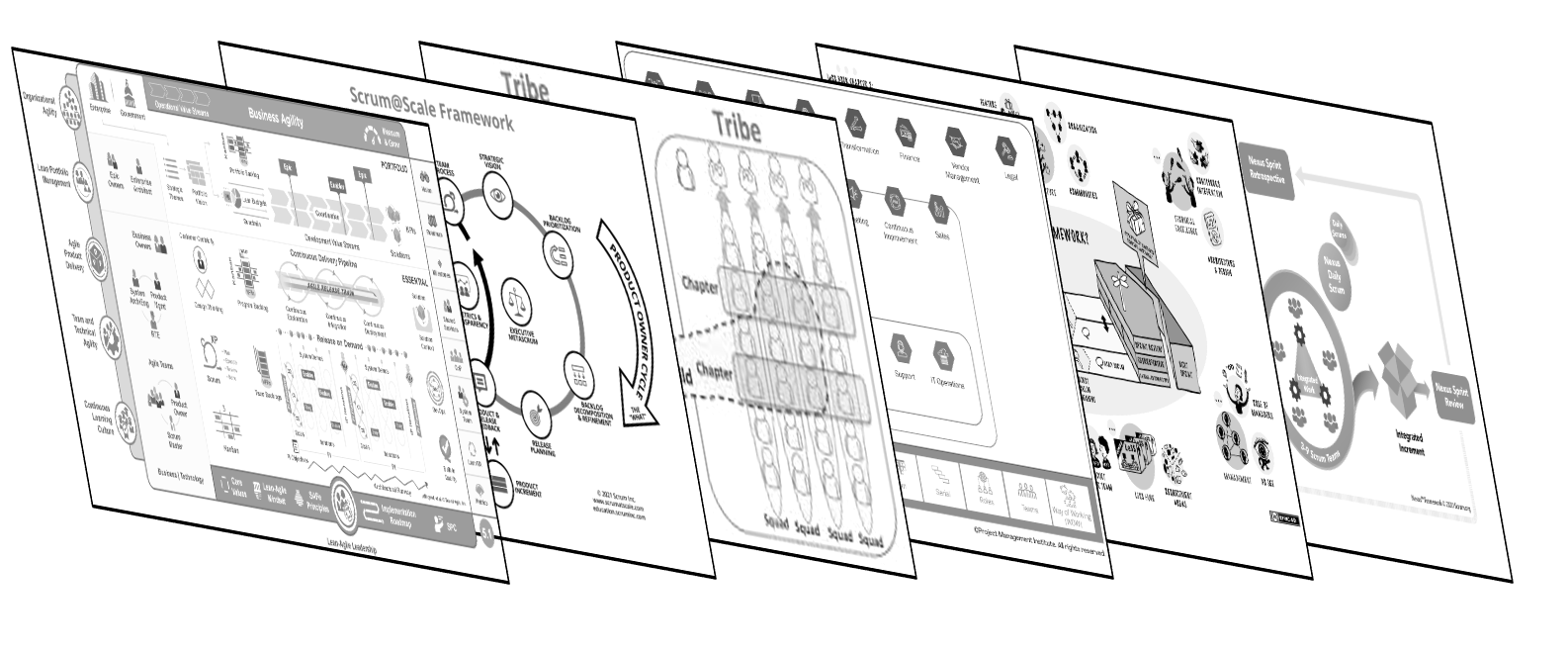
Image source: compare with framework references
In other words, all the frameworks like to apply the same values & principles to our suppliers and partners, which is very good at least in theory :-)
Find out more about suppliers in agile in the article suppliers@SAFe.
REALITY CHECK - TOP 3 CHALLENGES WITH SUPPLIERS WHILE SCALING AGILE?
CHALLENGE 1: WHO’S RESPONSIBLE FOR THE SUPPLIERS?
In non-agile organizations the commercial functions such as sales, procurement, partner management, etc. have been responsible for the supplier management. To be honest the agile community hasn’t really found a more agile way for most of those tasks and responsibilities yet. They are mainly treated as shared services. In the best case they’ve visualized their work via a Kanban Board or started to experiment with Scrum. If you think of your latest negotiation you’ll agree that they are far away from applying agile values yet.
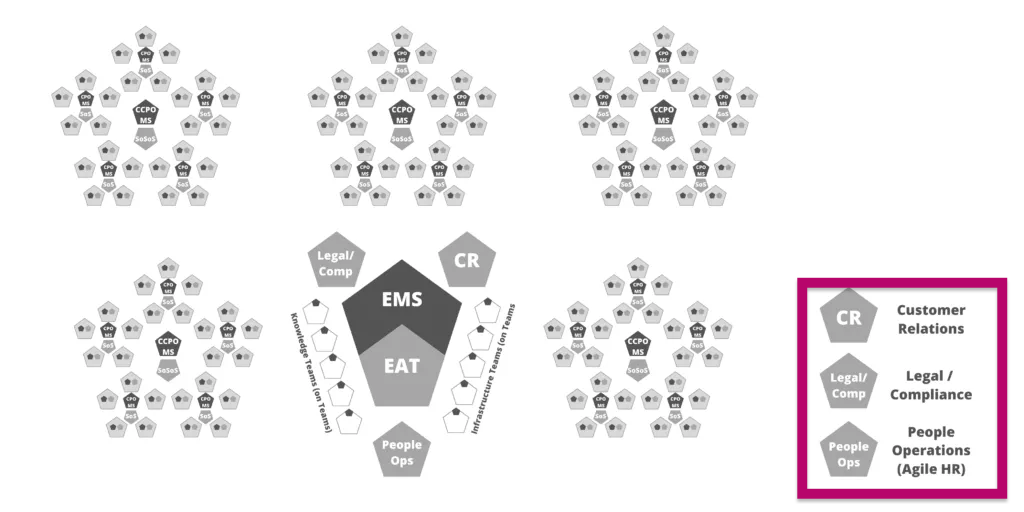
Image source: scrumatscale.com
To be fair, good Scrum Masters or on higher level Scaled Scrum Masters have taken over some of the tasks to e.g. manage a supplier, the contracts, etc.
“Procurement & Sales are responsible for up to 80% of a Company’s revenue”
— Chief Procurement Manager leading Bank in UK
The potential is huge if we think of the fact that procurement and sales are responsible for up to 80% of a company’s revenue!-Imagine the direct business impact, if we could improve time-to-market by just some percentage?!
CHALLENGE 2: HOW TO SELECT KEY PARTNERS?
In Portfolio Management where often the need for a new strategic partnership is defined today we’re using e.g. the Business Canvas. The canvas has a section “Key Partners”, but there’s no approach based on agile values & principles to find and select those.
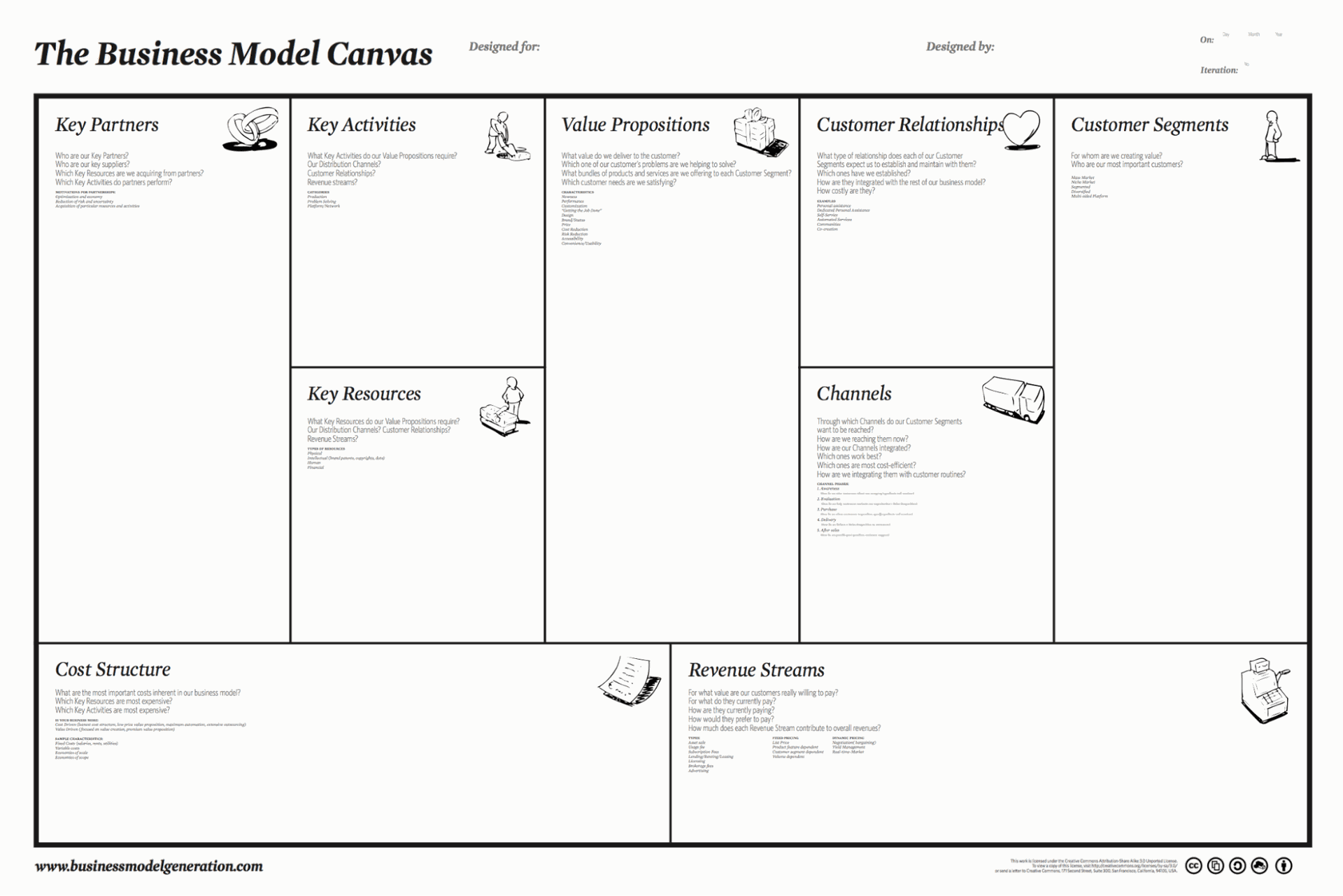
Image source: strategyzer.com
Find out more selecting a partner in agile e.g. in the article Strategic Vision & Backlog Prioritization in Scrum@Scale.
CHALLENGE 3: HOW TO ALIGN CONTRACTS WITH AGILE COLLABORATION?
The global annual State of Agility in Procurement & Supply showed that 78% of professionals in commercial functions have less than 3 years experience in Agile Contracts.
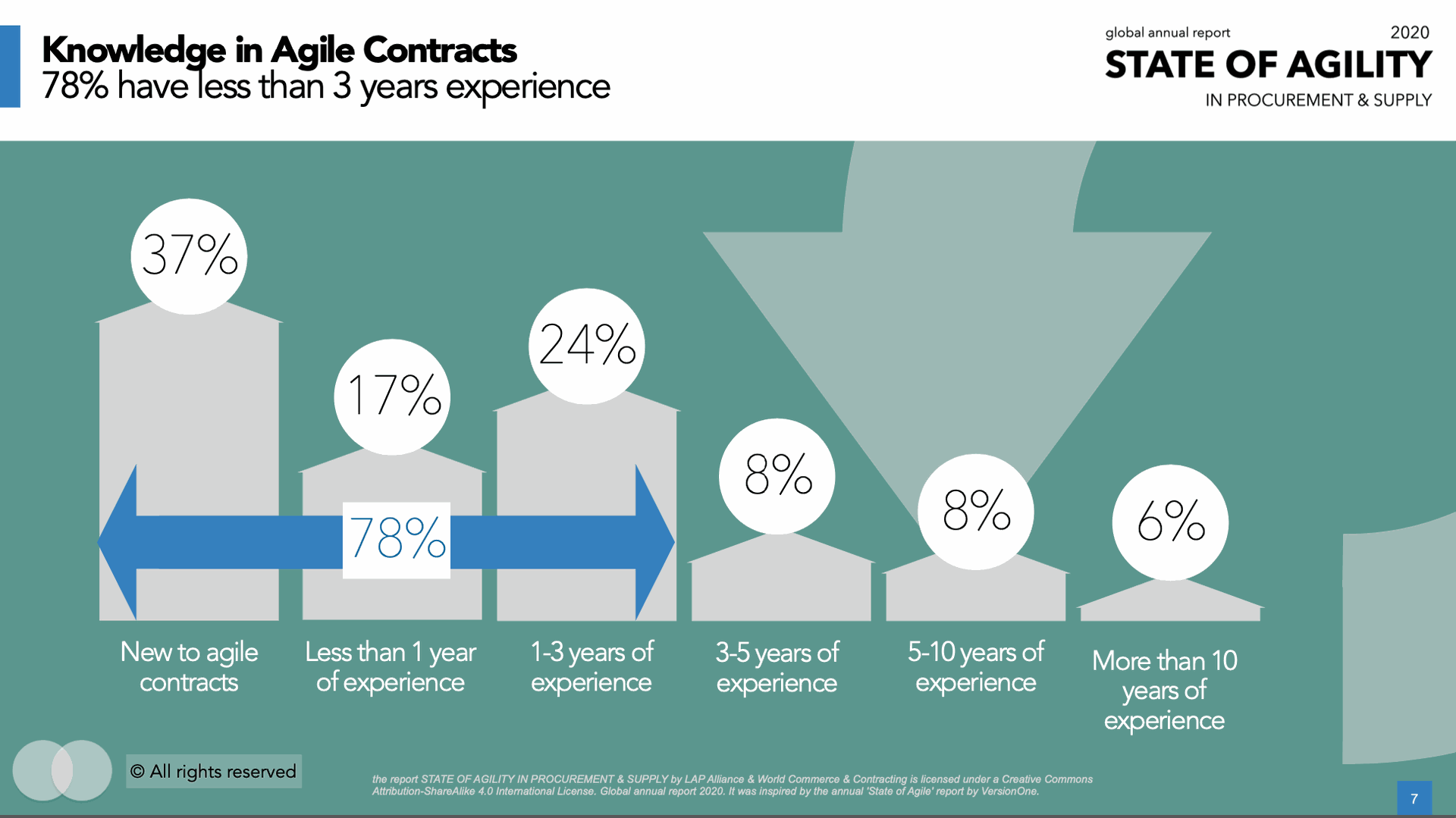
Image source: LAP Alliance
In other words even if the parties like to collaborate in an agile way they most likely suffer from a good legal foundation.
Find out more in the article Agile Contracts in SAFe or download the full report about the State of Agility in Procurement & Supply here.
SCALING CROSS-COMPANIES WITH LEAN-AGILE PROCUREMENT!
Let’s find out what we could learn from DevOps, how you’ll improve time to market by 400-800% applying Lean-Agile Procurement to your supplier selection approach and how all of this will help you in scaling agile cross-company.
HISTORY
Traditional sourcing approaches are transactional 3, where the buyer side defines the scope and the supplier side offers a solution incl. price for it. This process called Request for Proposal (short RfP) hasn’t really changed in the past 120 years. If applied to complex cases such as e.g. introducing a new ERP system with a new partner it delays time to market by 6-12+ months on average 4. The main reason is that all the details in scope e.g. new business processes, technical integrations, etc. can’t be foreseen in a reasonable amount of time or will change as we go.
LEAN-AGILE PROCUREMENT IN A NUTSHELL
Lean-Agile Procurement (short LAP) was invented to introduce an approach to find and select a key partner based on agile values & principles in DAYS instead of months. The selection is highly collaborative, similar to a PI-planning having all the right people from all parties -even competitors- in the same room co-creating their proposals and an agile contract together. LAP has become the global standard, winning in 2020 the World Procurement Awards with the success story “Sourcing an ERP System in just 2 DAYS” 4 and is currently changing the view on Business Agility.
Of course will the sourcing of all the simple to complicated staff such as e.g. stationary be digitized. Those so-called operational tasks are up to 90% of such centralized services. In other words the sweet spot of LAP is complex or strategic sourcing 3.
THE AGILE TEAM REDEFINED
After more than 5 years experience applying LAP in every industrie it became obvious that in a truly agile organization consisting of team-of-teams e.g. procurement, sales and partner management will become additional capabilities every agile team needs to have. Some people call LAP “DevOps on Steroids” or just the next logical evolution of it.
“Lean-Agile Procurement is like DevOps on Steroids!”
— Senior Agile Coach
In practice this means we add all capabilities we’ll need to define strategy, customer needs, sourcing strategy, delivery, operation and even to contract to an agile team. In other words the agile team gets full ownership over the product livecycle. While applying LAP e.g. in Banking it turned out that compliance is a huge roadblocker, so we added somebody from compliance to the team too.
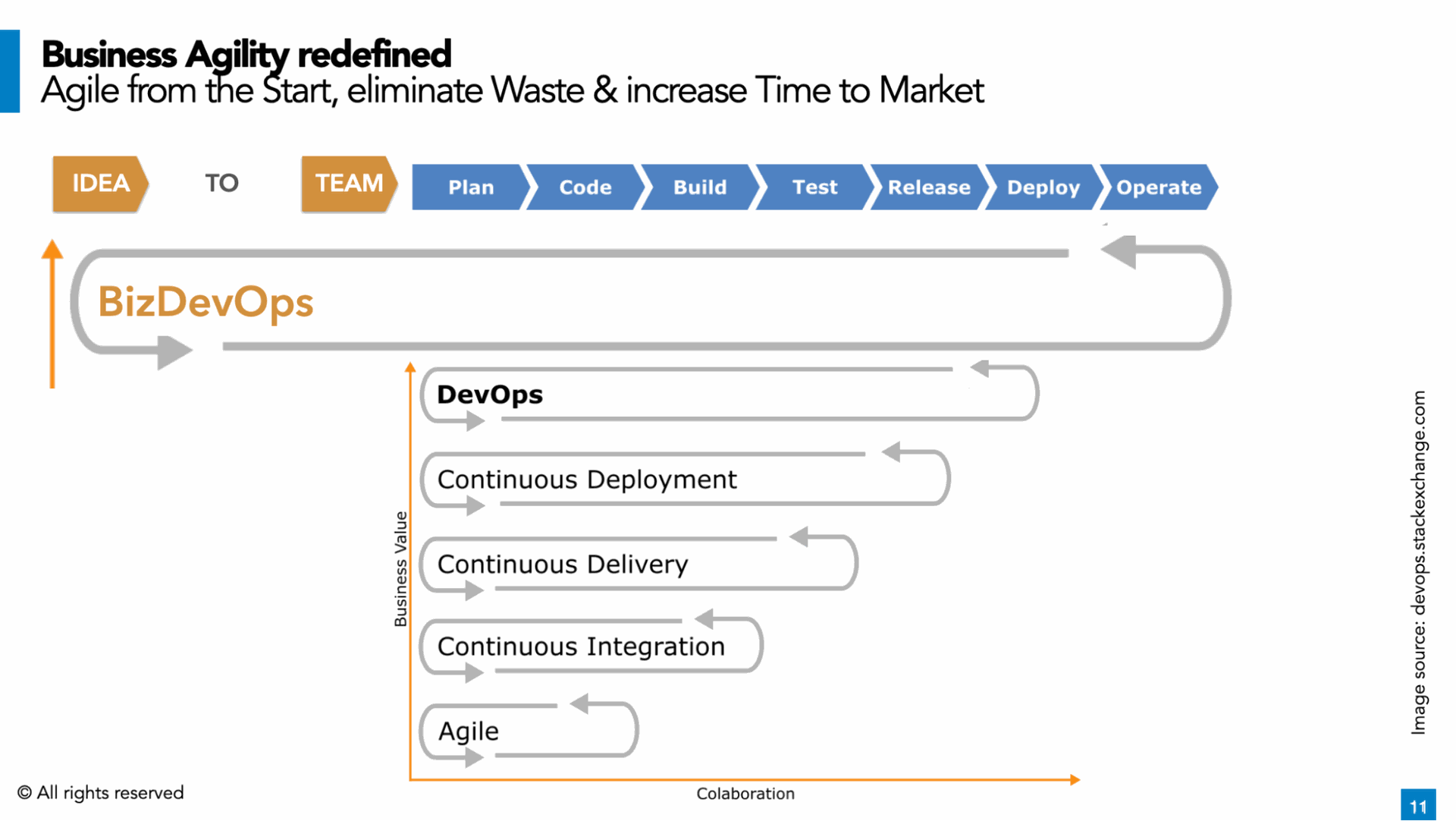
Image source: LAP Alliance
A further advantage of such an end-to-end agile team or team-of-teams is that we overcome the transactional nature of e.g. sourcing. As we all know handovers are always a risk, delaying time-to-market, etc.
THE LEAN PROCUREMENT CANVAS
LAP doesn’t make the existing sourcing process more efficient. Instead the focus lies always on being effective – doing the RIGHT things. In an uncertain environment this also means saying goodbye to detailed specifications, and accepting that anything can change at any time. In today’s smart business development scene the Business Model Canvas 5 is a living document and 100-page business cases are a thing of the past. LAP demands the same for defining a partnership, and the Lean Procurement Canvas 2 provides it.
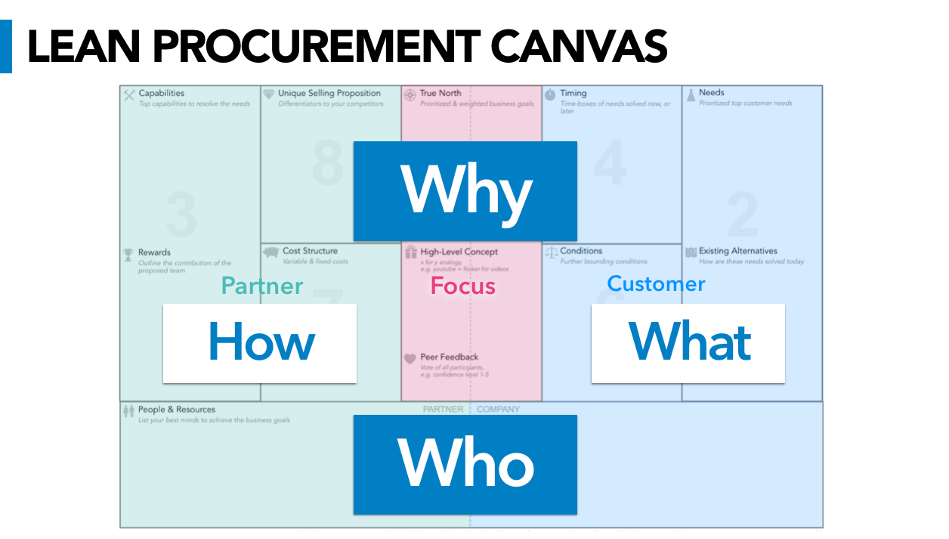
Image source: LAP Alliance
The canvas is divided in the right / left side, where on the right the customer or buyer side is represented and on the left we gather the information about the partner or supplier. The four main sections are about the WHY <> WHAT <> HOW. As an integral part of the canvas we also define the WHO or the people from both parties that will collaborate. A social- and cultural fit turned out as a very important success criteria for any collaboration.
For more details download the cheat sheet or start with it in your favorite tool Mural.co / Miro.com.
“By focusing to the customer needs Tesla never ran into a Chip shortage”
— Joe Justice Authored Scrum Master (book), created eXtreme Manufacturing, founded WIKISPEED.
During the Covid-19 crisis the big German car manufacturers ran and are still running into huge shortages e.g. in Computer Chips. Main reason was that their sourcing strategy was based on lean principles only. They in fact had prefered suppliers for each component and the component was exactly defined with focus to the HOW and the lowest price. With LAP we focus on the buyer side on the WHY and WHAT and wanna stay as agile on the HOW and with that also on the supplier. Following this principle Tesla never ran into that problem until today.
“The Lean Procurement Canvas is an Agile Contract”
— Ursula Sury, lic jur, Die Advokatur AG
It turned out that the Lean Procurement Canvas is to most lean Agile Contract beside a verbal agreement.
The Canvas can be used by startups, corporations who would like to:
- Setup and align a new internal, mixed or outsourced 3rd party agile product delivery team
- Co-create an agile agreement with multiple vendors in the same room simultaneously
- Assess and manage existing teams or partnerships with 3rd parties
- Close a deal more effectively as a vendor
It has been used by Air France KLM, Gazprom, BNP Parisbas, Auckland Council and many more from the private and public sector.
SAFE / SCRUM@SCALE / ETC & LAP APPROACH - SOURCE A KEY PARTNER IN DAYS!
Let’s see how all fits together and how you could source a key partner in DAYS too!-The LAP Approach has four generic steps that need to be implemented in every context differently. The Lean Procurement Canvas is our guiding tool, while it is by definition a living document throughout a partnership and can always just be a summary. We usually end up with a ton of attachments to it such as e.g. personas, a user story map, collaboration model, contractual framework, etc.
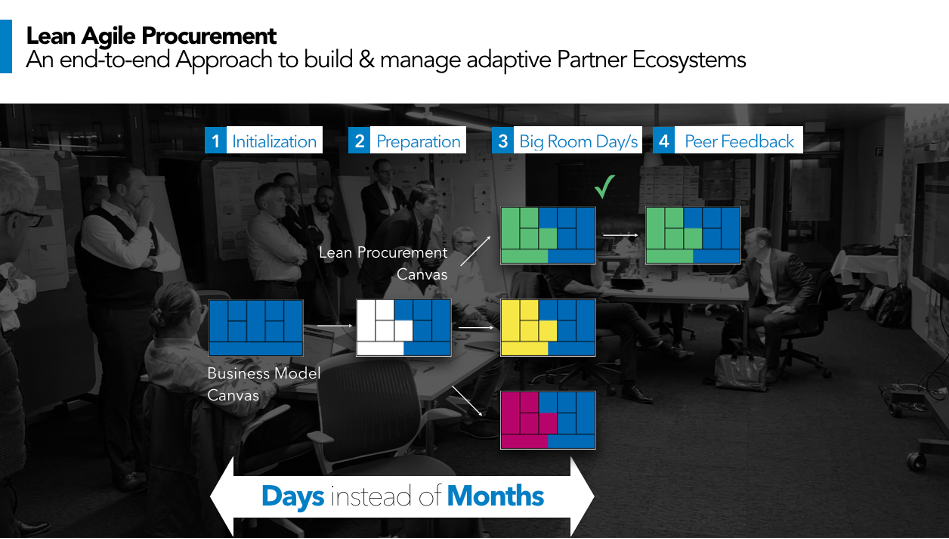
To make it more clear, find the following four generic steps of the LAP Approach and some explanation how this could fit into SAFe, Scrum@Scale and the Spotify “Model”.
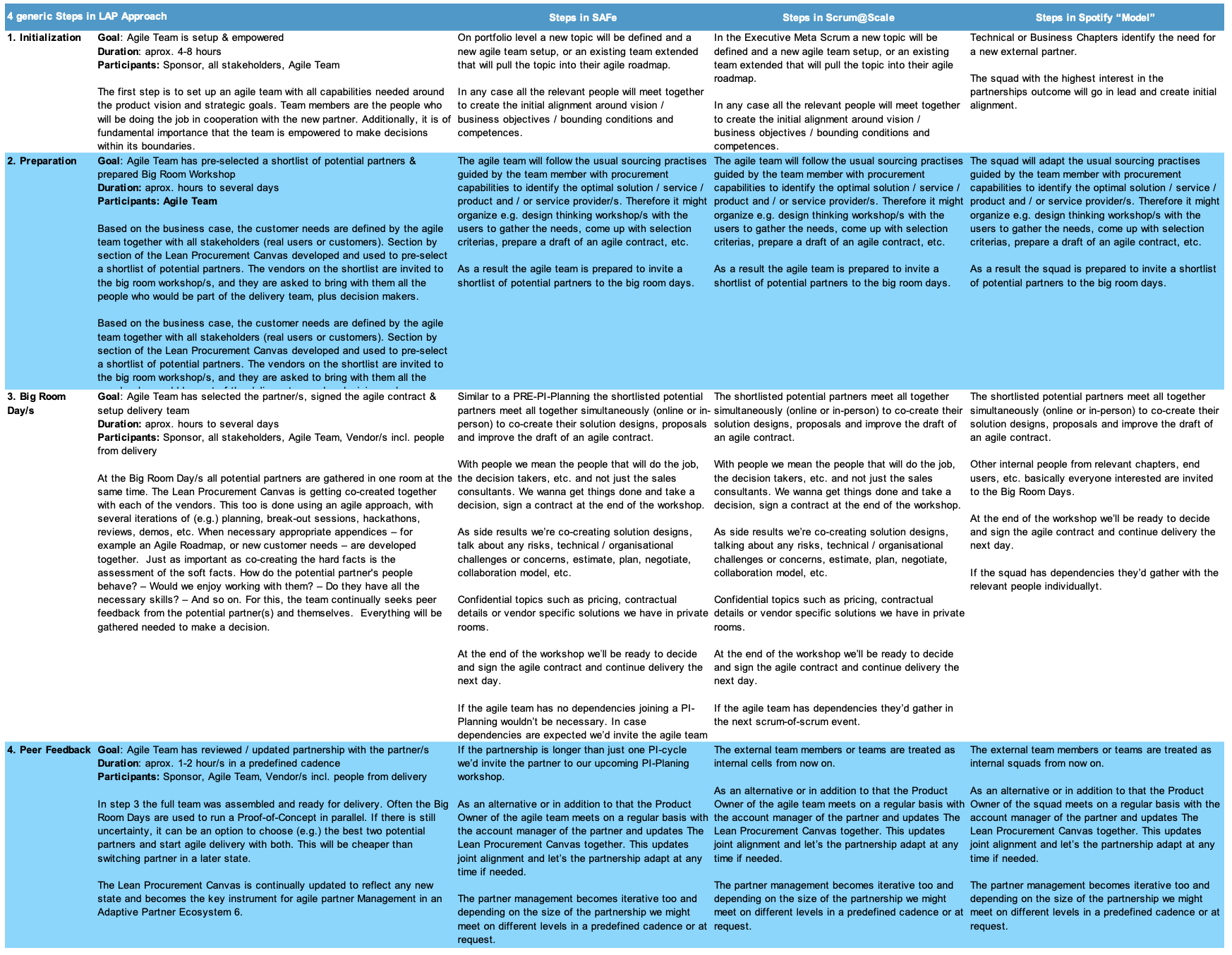 Image source: LAP Alliance
Image source: LAP Alliance
Find out more about the Big Room Workshop/s in LAP in the Article Big Room Workshop.
BUSINESS OUTCOMES WITH LEAN-AGILE PROCUREMENT
CKW a swiss Energy Company together with flowdays, won the 2018 CIPS-Europe award 7 at the Budapest ProcureCon event. Find some empirical data from that success story to get an idea about the business outcomes with LAP in comparison to traditional sourcing approaches.
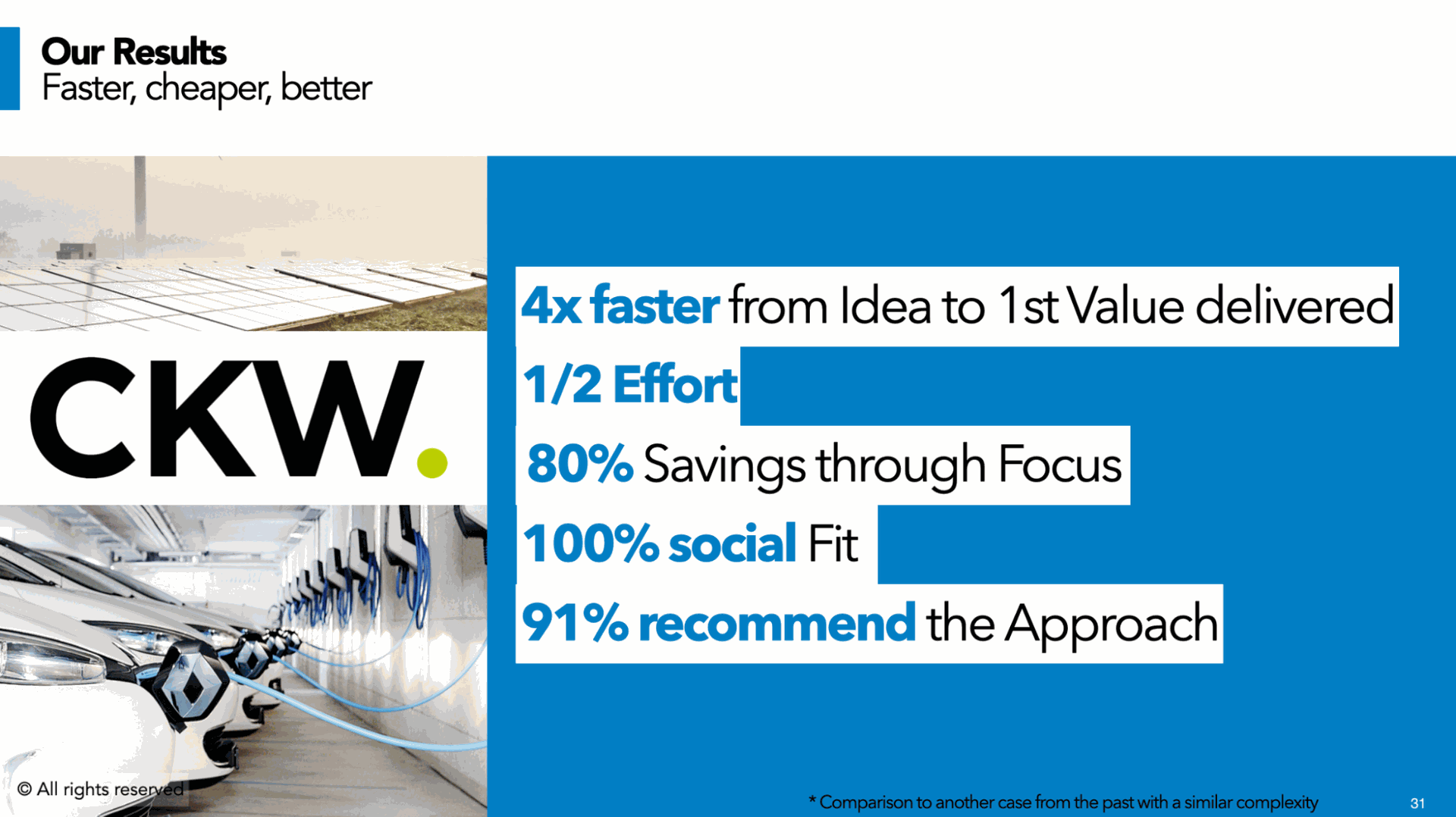
Time-to-market was radically improved from 4 months to 4 weeks while the efforts could be cut in half. Through focusing to prioritized customer needs and talking about any risk / concern, etc. while the big room workshop we’re able to improve spent by 80%. The agile team assessed not just the best product, but the full package including the best social- & cultural fit. 9 out of 10 recommended the LAP Approach, even the shortlisted vendors that didn made it.
In terms of delivery the project was a success too. The jointly agreed objectives have been overachieved within the initial budget and time. In fact the team was faster as expected and could add more to the initial plan.
Beside the success of the project with LAP we deliver value faster and create the business outcomes earlier, which often means millions depending on the case.
CONCLUSION
Lean-Agile Procurement extends the point of view of Business Agility to the external partners and fosters a thinking of Adaptive Partner Ecosystem 6 instead of a static supply chain. Where the agile team is the core of an agile organisation and needs to extend their capabilities with procurement / sales / partner management skills to own the whole product life cycle.
Also it gives an answer to the 3 challenges with suppliers in scaling Agile frameworks and applies the same principles of co-creation as in e.g. a PI-Planning to sourcing and partner management, while an agile contract is more seen as the result of the agreement developed in the Big Room Workshop.
Agilists applying any of the existing Scaling Frameworks have the potential to become pioneers by creating much bigger business impacts faster by scaling agile cross-company with Lean-Agile Procurement.
More than that, a pilot with LAP is also a very good starting point for a company becoming agile. In most of our success stories the company wasn’t agile yet, or not yet in the leadership and for sure not in Procurement nor Sales. The urgency of a strategic sourcing case helped to get the management support and as with an end-to-end agile team we’re introducing a flavor of agility in every function LAP turned out as a very good catalyst!
The original article was written to https://www.lean-agile-procurement.com/ You can read the original at: https://www.lean-agile-procurement.com/blog-1/2021/12/20/scaling-agile-beyond-companies